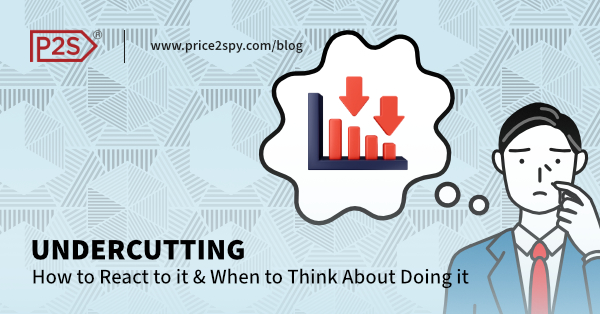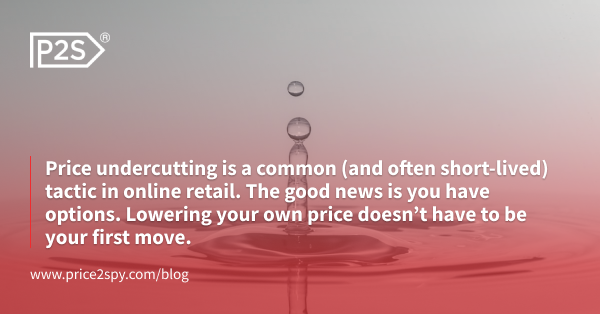
Undercutting: How to React to it & When to Think About Doing it
Few things spark a stronger reaction in business than being undercut. It can feel like a cheap shot, a bold move, or just plain annoying.
The truth is, though, that it’s a reality of many markets. How you respond to it can make all the difference.
The main question is: do you grit your teeth, fight back, or join the price-drop party? Let’s first go over everything you need to know about undercutting. Then we will give you tips on how to react to it and when to actually think about doing it yourself.

What does undercutting mean?
Undercutting is the act of reducing your prices relative to a specific competitor.
Most commonly the goal of this action is to gain more market share, a competitive edge, and more. It is most frequently encountered in commoditized and saturated markets.
Besides these two factors, there are some additional characteristics of markets in which undercutting is frequently encountered:
- Near-perfect competition. Near-perfect (or perfect) competition means that the market has many buyers and sellers, homogeneous products, free entry and exit, perfect information, and that no single company can influence the price on its own. These conditions make undercutting almost inevitable, as the price becomes the only instrument with which sellers can attract attention and make sales.
- High fixed costs, low variable costs. When it costs (almost) nothing to serve an additional customer, cutting prices becomes an attractive (and risky) method to gain sales volume.
- High price elasticity of demand. When demand sharply increases with the smallest price drops, this is when we say that the price elasticity of demand is high. These increases in demand are strong motivators for sellers to drop their prices and help explain frequent undercuts. Online retail is a prime example market that is characterized by such customer behavior.
- Transparent pricing. Transparent pricing is also extremely common in online retail and eCommerce. We say a market has transparent pricing when customers can easily compare prices across sellers. In these conditions customers can purchase from the cheapest seller at the moment they want to buy, especially online.
- Low barriers to entry. Nowadays, it is relatively easy to become a dropshipper or Amazon third-party seller. There’s little to no differentiation in this market. Basically, the only remaining differentiating factor is the price. This means that every new seller will look to undercut the current competitors and gain a market share of their own.
What to do when a competitor undercuts your prices?
Did your competitor just swoop in with a lower price on the same or similar product? That’s annoying, and it’s perfectly understandable to feel that way.
One day, you’re confidently selling your product, and the next, someone shows up offering the same or similar product at a lower price. It’s frustrating, sometimes even a little personal. There are thousands of questions running through your mind.

Don’t panic. Price undercutting is a common (and often short-lived) tactic in online retail. The good news? You have options. Lowering your prices doesn’t need to be your first move. Let’s walk through what you can do instead.
- Don’t immediately lower your prices. You may feel panic and go for the option of matching your competitor’s new lowest price. Think twice about this. Reactively slashing prices can trigger a race to the bottom. This can destroy your margins without actually guaranteeing sales.
- Focus on your unique value proposition. As we have said, in commoditized markets, price is king. However, if you have a unique offer, then you may have more leeway for charging a premium. Alternatively, think about your brand’s strengths and the overall customer experience in your store – where do you stand among your competitors?
- Double-down on personalization and loyalty programs. The goal of personalization and loyalty programs is to increase the number of returning customers. This is because returning customers are less price sensitive. They trust your brand.
- Offer excellent customer service. This point goes hand-in-hand with the previous one. Both personalization and excellent customer service work towards increasing customers’ trust in your brand.
- Target more niche markets. Niches reduce direct competition and make price less important if you serve a specific need exceptionally well. Focus on targeting a specific audience with a specific problem to be solved. For example, if you are selling office furniture, and you get undercut on a desk price, you can focus on selling ergonomic tools for people with back problems.
Extra tip #1: Be prepared. Anticipate the possibility of being undercut in the future again. Once again, take a look at the section above, where we have described the characteristics of markets where undercutting is most common. Think if those are characteristics of the market you are in. If so, plan ahead.
Extra tip #2: Monitor the market. Don’t wait for a competitor’s price drop to affect your sales. Know when the undercut happens in real-time. Use price monitoring tools to gain timely and comprehensive market insights. These tools will help you shorten you reaction time and minimize your losses.
When should you think about undercutting?
Firstly, make sure you have performed proper market research. Carefully consider your capacities and lay out your goals. Why do you want to go below a competitor’s price?
Ask yourself: “What’s my goal? Can I afford it? Will it hurt my brand? What’s my exit strategy? Will I win something more valuable than the sale itself?”

Undercutting as an act of desperation rarely, if ever, works. Only implement this pricing strategy as a part of a larger game plan.
Here are some scenarios in which undercutting may be warranted:
- Gaining traction in a new market. Keeping prices below your competitors’ when entering a new market is more commonly known as penetration pricing. It is a form of undercutting, but in most cases there is a long-term plan of capitalizing on the gained market share by introducing lower prices.
- Getting rid of excess or seasonal inventory. When you have limited time to sell certain items (e.g. due to them being holiday goods or perishable items), you may find it necessary to undercut. Many retailers cut prices to clear stock quickly and prevent it from turning into dead inventory.
- Loss-leader pricing strategy. In short, a loss leader is a product you intentionally sell at a loss to achieve one of two goals: (1) bring customers into your brand’s ecosystem, or (2) encourage them to buy additional products alongside it to compensate for the loss. Even though you undercut the price on the loss leader, you earn profits through repeat purchases, upsells, or bundled deals.
- Competing in a hyper price-sensitive market. When selling to price sensitive consumers, price is the main factor behind purchase decisions, there’s no two ways about it. In such markets, undercutting is the name of the game. This is a common characteristic found in budget electronics or commodity goods markets.
- Short-term aggressive play against a weaker competitor. When based on competitive intelligence you know that your rival can’t sustain low prices for too long, you may consider undercutting. This may lead to weakening your rival’s market position and taking over a part of their customer base.
Undercutting compared to other pricing strategies
Undercutting vs penetration pricing
Penetration pricing differs from undercutting in that it’s a broader strategy. It entails undercutting during its initial phases. However, at later stages the losses are made up for by price increases. Think of undercutting as a part of penetration pricing.
Undercutting vs competitive pricing
There are three main repricing tactics when talking about competitive pricing:
- Staying above your competitor’s price;
- Staying below your competitor’s price, and
- Staying equal to your competitor’s price.
As you can see, undercutting is actually a subtype of competitive pricing. It does mean choosing a competitor or a desired market position and relating your price to it. It is not uncommon to sometimes even mistake competitive pricing with undercutting.
Keep in mind that this doesn’t have to be the case. Competitive pricing can also mean capitalizing on market opportunities made by your competitors’ poor pricing choices. This can mean increasing or keeping prices equal when needed.
Undercutting vs dynamic pricing
Undercutting is when a business lowers its prices specifically to beat a competitor’s prices and attract more customers. In a way, it’s like saying, “Hey, we’re cheaper than them! Come shop here instead.”
Dynamic pricing, on the other hand, is when prices change based on factors like demand, time of day, or inventory. Think of airline tickets or Uber rides that get more expensive during busy times. In essence, undercutting is about beating others, while dynamic pricing is about adapting to the market.
Undercutting vs price skimming
Price skimming also means price drops, but in a different way. These price drops aren’t related to any particular competitor, nor is the goal of price skimming to be the cheapest seller.
The goal of price skimming is to skim profits from different customer segments by gradually reducing the price of a product over time. It usually starts by capitalizing on early adopters and highly loyal customers. Then, with a first price drop, the seller turns to customers in need who are actively looking for a solution to their problem. Another price drop may bring the seller in front of more price sensitive customers. Further drops may get the seller’s product to be bought by bargain hunters and impulse buyers.
Conclusion
Getting undercut feels frustrating. Undercutting a competitor is risky. Yet, sellers still have this pricing tactic in the back of their minds. And contrary to the popular belief, that may be a good thing.
Here’s the thing. Undercutting is risky when done without preparation and limits, because it can hurt your margins beyond recovery and can spiral into a pricing war.
On the other hand, it can be a helpful tactic to clear out inventory, improve your market share and positioning, and even a necessity in highly competitive markets.
The key thing is to be mindful when using this pricing tactic. Always go back to the goal you want to achieve with it, while being on the lookout for risks and pitfalls.



